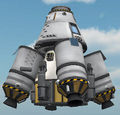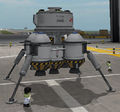Difference between revisions of "Lander"
m (→Aspects of design: Fixed header levels.) |
|||
| Line 4: | Line 4: | ||
==Aspects of design== | ==Aspects of design== | ||
The main aspect of design - although many times forgotten - if the unit is a landing only or even able to reach orbit again. The landing only units usually are a kind of [[probe]]s, or transfers something attending to leave on the surface like [[rover]]s or [[base]]s, or the elements of them. Even ability of reaching orbit does not mean necessity of docking ability - as the [[kerbonaut]]s can reach the ship by [[EVA]]. What is the reason on this concept? The lack of [[docking|docking ports]] and the [[RCS|reaction control system]] saves mass! Mainly a returning stage consisting a single [[command module|capsule]] and a [[parachute]] is simplistic lander for [[Kerbin]]. Except of this one-way atmospheric descending the high [[thrust-to-weight ratio]] is advantageous at both landing and ascending. | The main aspect of design - although many times forgotten - if the unit is a landing only or even able to reach orbit again. The landing only units usually are a kind of [[probe]]s, or transfers something attending to leave on the surface like [[rover]]s or [[base]]s, or the elements of them. Even ability of reaching orbit does not mean necessity of docking ability - as the [[kerbonaut]]s can reach the ship by [[EVA]]. What is the reason on this concept? The lack of [[docking|docking ports]] and the [[RCS|reaction control system]] saves mass! Mainly a returning stage consisting a single [[command module|capsule]] and a [[parachute]] is simplistic lander for [[Kerbin]]. Except of this one-way atmospheric descending the high [[thrust-to-weight ratio]] is advantageous at both landing and ascending. | ||
| − | + | ||
| + | ===Gravity=== | ||
The main factor of the design is the surface gravity of the celestial body. The lander can be single staged - and even reusable (essentially a local [[SSTO]]), or disposable one-multi-staged. It is possible to map the body by hopping over with several ascending and landing after leaving the stable orbit. The usage of single stage is not practical on heavier bodies, moreover many times the multi-staged design is inevitable. As the lander is among the [[payload]] at the [[launch]], the [[asparagus staging]] is more cost efficient due to lighter construction, as employment of the basically cheap [[solid rocket booster]]s. The two stage design practically contains a landing unit, and an ascending unit, leaving the parts needed only for landing, like the [[landing leg]]s and the [[parachute]]s behind for achieving the more efficient ascending. | The main factor of the design is the surface gravity of the celestial body. The lander can be single staged - and even reusable (essentially a local [[SSTO]]), or disposable one-multi-staged. It is possible to map the body by hopping over with several ascending and landing after leaving the stable orbit. The usage of single stage is not practical on heavier bodies, moreover many times the multi-staged design is inevitable. As the lander is among the [[payload]] at the [[launch]], the [[asparagus staging]] is more cost efficient due to lighter construction, as employment of the basically cheap [[solid rocket booster]]s. The two stage design practically contains a landing unit, and an ascending unit, leaving the parts needed only for landing, like the [[landing leg]]s and the [[parachute]]s behind for achieving the more efficient ascending. | ||
| − | + | ||
| + | ===Atmosphere=== | ||
The density of the [[atmosphere]] of targeted body is also an essential factor, as the dense atmosphere can make employment of [[heat shield]]s inevitable. Although in this case using of [[parachute]]s and [[A.I.R.B.R.A.K.E.S]] can save copious amount of [[fuel]]. The type of the [[engine]] also depends on the atmospheric pressure, as many engine work excellently in vacuum, in dense atmosphere inefficient and cannot produce enough thrust, causing extra fuel loss over the [[drag]]. | The density of the [[atmosphere]] of targeted body is also an essential factor, as the dense atmosphere can make employment of [[heat shield]]s inevitable. Although in this case using of [[parachute]]s and [[A.I.R.B.R.A.K.E.S]] can save copious amount of [[fuel]]. The type of the [[engine]] also depends on the atmospheric pressure, as many engine work excellently in vacuum, in dense atmosphere inefficient and cannot produce enough thrust, causing extra fuel loss over the [[drag]]. | ||
| − | + | ||
| + | ===Cargo=== | ||
The possible construction greatly depends on the type of the cargo has to put on the surface. Of course, the most common cargo is a small group of [[Kerbal]]s. There is great assortment of splendid [[command module|cabins]] for our green employees to do this, and there are some special [[habitation module|passenger module]] too. Only a properly placed [[ladder]] is required for reaching it from the surface. For delivering [[rover]]s or modules of [[base]]s [[Decoupler and separator/hu|decoupler, separator]] or docking ports needed for decoupling. | The possible construction greatly depends on the type of the cargo has to put on the surface. Of course, the most common cargo is a small group of [[Kerbal]]s. There is great assortment of splendid [[command module|cabins]] for our green employees to do this, and there are some special [[habitation module|passenger module]] too. Only a properly placed [[ladder]] is required for reaching it from the surface. For delivering [[rover]]s or modules of [[base]]s [[Decoupler and separator/hu|decoupler, separator]] or docking ports needed for decoupling. | ||
| − | + | ||
| + | ===Connection=== | ||
And finally some words about the connection to the [[ship]] as they needs a carrier for the interplanetary traveling. Decoupler works excellently in basic case, but the docking port even makes the reattachment and [[fuel transfer|refueling]] realizable. The connection among docking ports can be made more rigid using [[strut]]s, but for using the lander on several celestial bodies the connection must be properly stark relatively to the mass of the lander. | And finally some words about the connection to the [[ship]] as they needs a carrier for the interplanetary traveling. Decoupler works excellently in basic case, but the docking port even makes the reattachment and [[fuel transfer|refueling]] realizable. The connection among docking ports can be made more rigid using [[strut]]s, but for using the lander on several celestial bodies the connection must be properly stark relatively to the mass of the lander. | ||
Revision as of 18:17, 23 September 2015
The Lander is a special craft, usually part of a greater ship which can land on the surface of a celestial body. The design of the lander mainly determined by the main properties of the body, mainly the density of the atmosphere and the surface gravity hedges in the possible design of the lander. Long story short: different designs work efficiently on each different type of body. As a result of this maybe the landers form the most diverse and most experience needing group of the crafts.
Aspects of design
The main aspect of design - although many times forgotten - if the unit is a landing only or even able to reach orbit again. The landing only units usually are a kind of probes, or transfers something attending to leave on the surface like rovers or bases, or the elements of them. Even ability of reaching orbit does not mean necessity of docking ability - as the kerbonauts can reach the ship by EVA. What is the reason on this concept? The lack of docking ports and the reaction control system saves mass! Mainly a returning stage consisting a single capsule and a parachute is simplistic lander for Kerbin. Except of this one-way atmospheric descending the high thrust-to-weight ratio is advantageous at both landing and ascending.
Gravity
The main factor of the design is the surface gravity of the celestial body. The lander can be single staged - and even reusable (essentially a local SSTO), or disposable one-multi-staged. It is possible to map the body by hopping over with several ascending and landing after leaving the stable orbit. The usage of single stage is not practical on heavier bodies, moreover many times the multi-staged design is inevitable. As the lander is among the payload at the launch, the asparagus staging is more cost efficient due to lighter construction, as employment of the basically cheap solid rocket boosters. The two stage design practically contains a landing unit, and an ascending unit, leaving the parts needed only for landing, like the landing legs and the parachutes behind for achieving the more efficient ascending.
Atmosphere
The density of the atmosphere of targeted body is also an essential factor, as the dense atmosphere can make employment of heat shields inevitable. Although in this case using of parachutes and A.I.R.B.R.A.K.E.S can save copious amount of fuel. The type of the engine also depends on the atmospheric pressure, as many engine work excellently in vacuum, in dense atmosphere inefficient and cannot produce enough thrust, causing extra fuel loss over the drag.
Cargo
The possible construction greatly depends on the type of the cargo has to put on the surface. Of course, the most common cargo is a small group of Kerbals. There is great assortment of splendid cabins for our green employees to do this, and there are some special passenger module too. Only a properly placed ladder is required for reaching it from the surface. For delivering rovers or modules of bases decoupler, separator or docking ports needed for decoupling.
Connection
And finally some words about the connection to the ship as they needs a carrier for the interplanetary traveling. Decoupler works excellently in basic case, but the docking port even makes the reattachment and refueling realizable. The connection among docking ports can be made more rigid using struts, but for using the lander on several celestial bodies the connection must be properly stark relatively to the mass of the lander.
Gallery
Rover + Skycrane: lander for transporting a rover







